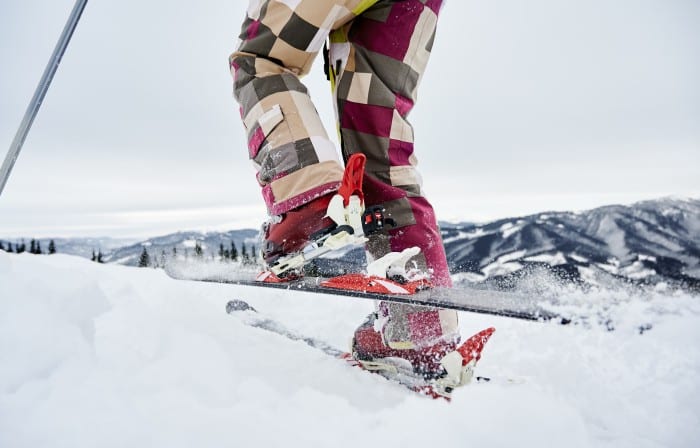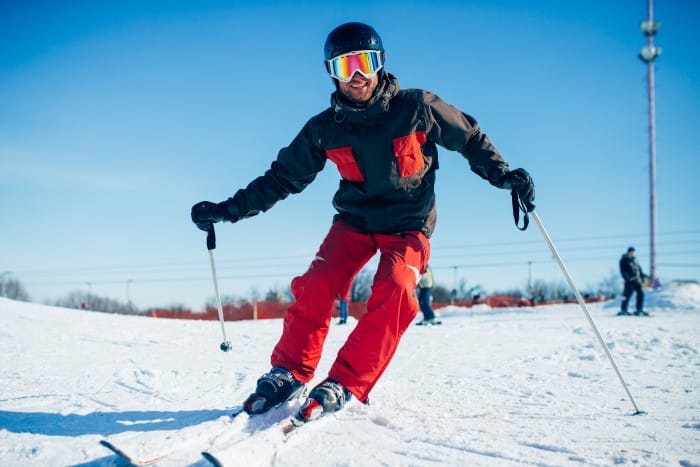A common saying when comparing skiing to snowboarding is that skiing is easy to learn but hard to master, whereas snowboarding is hard to learn but easy to master.
Skiing is easier to pick up than snowboarding due to it feeling more natural, but it’s harder to master because of its technicality. There’s a lot that goes into learning skiing beyond the basics, and the same cannot be said of snowboarding, which is easier to progress.
Below, we cover in detail why snowboarding is easier to master than skiing and the differences between the two sports in progression.
Learning to Ski vs Learning to Snowboard
When you’re just starting with skiing, you’ll tend to find that it’s easier to learn than snowboarding is.
There are four major factors that explain why skiing is easier to learn than snowboarding.
1. Separated Legs
First, when you’re falling while skiing, your legs will be separated from one another, meaning that if you begin to fall over, you’ll have an easier time catching and balancing yourself than in snowboarding.
This is because you can move your legs independently when skiing, as they’re not forcibly attached like snowboarding.
This mobility allows you to have a better chance at gaining balance, whereas, with snowboarding, you’ll have a harder time achieving a proper balance because your legs are attached to the board, meaning that if you fall, you’re done!

2. The Fundamentals of Skiing Can Be Broken Down
Another factor that makes skiing easier to learn for a beginner is that you can break down the fundamentals into just a few easily understandable steps.
For instance, turning can be extremely complex in skiing and depends on various factors, including weather, terrain, and snow quality.
However, the fundamentals can be broken down into a few core steps, making them easier to grasp and understand.
If you compare someone just starting with snowboarding to someone just starting with skiing, it’ll seem like night and day.
The beginner skier will quickly pick up new tactics, whereas the beginner snowboarder will be struggling with the fundamentals.
This is due to snowboarding having a difficult learning curve, as the basics feel unnatural and are hard to pick up.
Learning to turn, stop, and maneuver your heel and toe side edges are challenging concepts to understand and undertake, particularly if you’re new to board sports.
A common saying with skiing is that if you can walk, you can ski, which rings true for beginners learning the sport.
3. The Physical Stance
Skiing and snowboarding have differences in how riders stand on their given apparatus, which is referred to as a stance.
Skiers take on a stance that is facing straight toward the direction they’re going, reminiscent of walking or running.
In contrast, snowboarders have to take on a side stance, with their dominant foot facing forward.
This may take some time to get used to, and people who haven’t surfed or skated may take additional time to work out which stance is more comfortable.
This difference in stance gets exacerbated when you consider the distinctions in movement between the two sports.
Snowboarding requires maneuverability that can feel unnatural to many people just starting, not to mention getting off the lift!
In contrast, skiing may feel much more natural to beginners, and getting off the lift is as simple as standing up.
4. Differences in Fitness
There’s also a distinct difference in how physical activity affects skiers compared to snowboarders.
Skiers will feel the effect of their sport primarily in their legs and lower body, largely due to the continuous movement involved with bending the legs to turn and avoid any obstacles.
Snowboarders, on the other hand, will feel the effects of the sport primarily on their core due to the balance and posture needed to maneuver themselves around the mountain.
As many people tend to have stronger leg muscles than core muscles, this puts skiing at an advantage for those just starting out as snowboarders may have to adapt their bodies to the sport over time while still learning.

Progressing in Snowboarding vs Progressing in Skiing
Snowboarding and skiing have different rates of progression, and this is because of the differences in technique between the two sports and the time it takes to learn these techniques.
While specific skills are transferable between skiing and snowboarding, each sport has distinct attributes that set them apart.
For example, as skiing has two skis, many more postures and turn styles need to be learned compared to snowboarding.
1. Progressing in Snowboarding
The rate of progression in snowboarding after you learn the basics is relatively linear.
The fundamentals of snowboarding are the most challenging part of learning the sport, as it involves movements that may feel unnatural at first.
However, snowboarding starts to feel very streamlined once you achieve muscle memory, with progress increasing slower after this.
Once you have achieved the fundamentals, snowboarding can be relatively intuitive to progress through, with skill progression coming naturally as more familiarity is achieved.
After you have learned to turn, you can ride steeper and more challenging runs, learn to jump, and start hitting small features in the park.
Once you have more confidence, you can start riding different terrain, including trees, bowls, pipe, and bigger features in the park.
The same skills you learn as a beginner can be built upon to progress your riding ability as your confidence grows.
2. Progressing in Skiing
Progressing in skiing is unlike progressing in snowboarding. For one, advancing in skiing is hindered by the skis themselves.
As there are two skis, there are many more angles that a skier’s body has to make compared to snowboarders, and learning these precise angles is often time-consuming.
Similarly, skiing requires both legs to work in synergy.
This takes excellent coordination to maneuver both your legs in tandem, and gaining this skill takes a great deal of time, energy, and effort.
Turning with skiing itself holds various challenges as well.
Parallel skiing, one of the sport’s core techniques, is harder on flat and slow terrain than on quicker and steeper terrain, making it more challenging for beginners to advance.
There are also difficulties with implementing shorter turns, as these require tighter movement that can be hard to master.
Additionally, skiers often come face to face with moguls and other bumps, which can be extremely challenging to overcome.
All of this together makes progressing through the learning stages of skiing much more difficult and complex than progressing through the learning stages of snowboarding.
A lot of little skills have to be learned and add up to a large overall set of skills that don’t have a direct parallel to snowboarding itself.

Final Thoughts
Skiing is easier to learn than snowboarding but harder to master.
This is due to the differences in learning and progression between the two sports, with snowboarding having a higher learning curve for picking up the fundamentals due to the unnatural and unorthodox method of riding.
Skiing, on the other hand, is a lot more natural and easy to grasp for beginners. However, it is harder to progress through the stages of learning.
This is due to the technical nature of the sport that comes with learning all the intricacies beyond the fundamentals.
